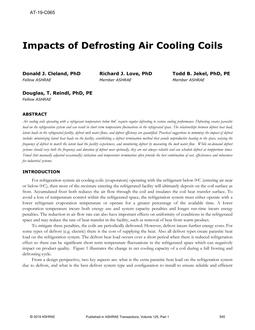Description
Air cooling coils operating with a refrigerant temperature below 0oC require regular defrosting to restore cooling performance. Defrosting creates parasitic load on the refrigeration system and can result in short term temperature fluctuations in the refrigerated space. The relationships between defrost heat load, latent loads in the refrigerated facility, defrost melt water flows, and defrost efficiency are quantified. Practical suggestions to minimize the impact of defrost include: minimizing latent heat loads on the facility, establishing a defrost termination method that avoids unproductive heating to the space, varying the frequency of defrost to match the latent load the facility experiences, and monitoring defrost by measuring the melt water flow. While on-demand defrost systems should vary both the frequency and duration of defrost near optimally, they are not always reliable and can schedule defrost at inopportune times. Timed (but manually adjusted occasionally) initiation and temperature termination often provide the best combination of cost, effectiveness and robustness for industrial systems.
Citation: 2019 Winter Conference, Atlanta, GA, Conference Papers
Product Details
- Published:
- 2019
- Number of Pages:
- 9
- Units of Measure:
- Dual
- File Size:
- 1 file , 5.4 MB
- Product Code(s):
- D-AT-19-C065




